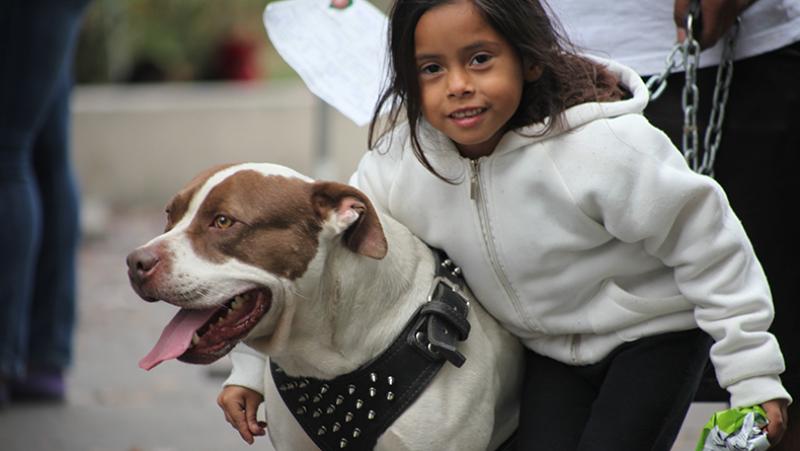Pets for Life
A GSSW team is studying whether an animal-welfare program also has community, human and environmental health impacts

When the Humane Society of the United States (HSUS) started its Denver Pets for Life program in 2016, it started with a vaccination clinic held at a local school. It was a Saturday morning in early spring, it was snowing like crazy, and even an hour before the clinic opened, the line stretched around the block, recalls Kevin Morris, a research associate professor in the Institute for Human–Animal Connection at the Graduate School of Social Work (GSSW).
Working with the Denver Animal Shelter, the program targeted residents in low-income communities in west and southwest Denver. People from marginalized populations and living in underserved communities like these often encounter barriers to accessing health care not only for themselves, but also their pets, Morris notes. Those barriers can include cost but also issues such as not being able to take pets on public transportation to get them to the vet. “Pets for Life breaks down barriers to services people want for their pets. These people don’t have any less of a bond with their pets; if you provide the services, they’ll stand in the snow for two hours waiting.”
In a new 4-year research partnership with HSUS, Maddie’s Fund and the Watershed Animal Fund, Morris is studying the impacts of Pets for Life, which aims to build humane communities by extending the reach of animal services, resources and information to underserved areas and addressing the need for accessible, affordable pet care. The goal of the study, he says, is to determine whether this type of intensive, focused animal-welfare program translates to broader community-level human and environmental health impacts.
HSUS is implementing Pets for Life in four new communities—Madison, Wisconsin; Wilder, Idaho; and Seattle and Granger, Washington—and has hired community-based research assistants, who are housed within humane societies in those communities and are collecting baseline data now.
The GSSW research team—including Clinical Professor Philip Tedeschi; Jessica Decker Sparks, PhD ’18; Research Fellows Sloane Hawes and Erin Flynn; and two dozen or so other graduate students—is collecting data at three levels. At the highest level, they’re gathering ZIP-code-level public health, crime, graduation, vaccination and other data. Data collection also includes qualitative interviews with residents in target communities, who will be asked to share perspectives on topics related to community cohesion, safety and social capital.
The third level uses a 115-question survey covering themes related to animal, human, community and environmental health and the interconnections between those domains. Because Pets for Life focuses on improving access to veterinary care and pet services, it offers a unique opportunity to test this One Health concept, Morris says. Two of the new sites will get Pets for Life for two years, while the other two communities will initially be comparison sites. After the first two years, all sites will have Pets for Life. Researchers will be looking for differences in things like child vaccination rates between the Pets for Life and comparison communities. “In the comparison community, can you create the change you saw in the Pets for Life community?” Morris asks. “And, are changes in the Pets for Life community sustainable?”
Pets and Poverty
Nationwide, tens of millions of people live in poverty with their pets, says HSUS. Pets for Life breaks down cultural and socioeconomic barriers by bringing services—everything from free dog training to pet supplies, wellness information and even transportation—into communities that may lack pet-service resources in addition to being underserved in other ways. Providing direct services in four cities and working in more than 30 others through a mentorship program, Pets for Life representatives systematically go door-to-door in a community, making multiple contacts and building trust one household at a time. Since Pets for Life was founded in 2012, tens of thousands of families, and more than 127,000 pets, have been impacted.
“They do this in a way that is incredibly culturally responsive,” Morris says. “They have an approach where they are providing a voucher for a free spay/neuter, but they also talk about the general health of the pet and emphasize strengthening the human–animal bond.”
Often when Pets for Life enters a community, Morris says, the spay/neuter rate for dogs and cats is below 10 percent; within a couple of years, the that rate is above 80 percent. There has been a misconception that people in low-income communities or communities of color are opposed to spaying and neutering, but in study findings published last year in the Journal of Applied Animal Welfare Science, the GSSW research team concluded that race and ethnicity are not primary determinants in use of veterinary services, but access to care is.
Pets for Life also has been working to reframe the understanding of and response to abuse and neglect. At the Denver vaccination clinic, one woman showed up hoping to get shots for her dog, who was “horribly matted,” Morris recalls. The Pets for Life representative asked if she’d tried to have the dog groomed. She had, but groomers wouldn’t work on the dog unless it had been vaccinated—something the owner couldn’t afford. Pets for Life vaccinated the dog and connected the owner with a groomer who would help. “This is a person who had tried to access services for her dog and encountered barriers. Pets for Life made it possible for this person to take care of her pet in the way she had wanted to.”
Do stories like this aggregate to change the data, moving the needle on broader community-level data points? That is what Morris and his colleagues at GSSW are trying to answer.
“Animals are just as important in these people’s lives as anyone else,” Morris says. “Helping maintain animals in people’s homes means maintaining a healthy social fabric.”



